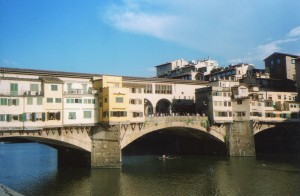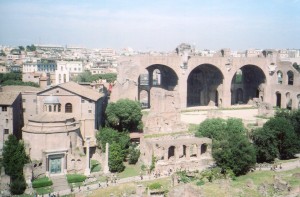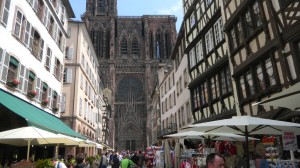I’ve been writing a lot of posts about Southeast Asia since I returned home from there, and rivers have helped shape much of the region’s thought. So here’s a reflection from Western currents.
Florence’s Ponte Vecchio spans the Arno river at its narrowest part. Ancient Romans had built a bridge there, but the river’s frequent floods destroyed many bridges from Roman and medieval times. The lowest part of the structure in the picture was constructed in the 14th century. But I find the buildings on top of it most interesting.
Florence’s merchants lined both sides of the Ponte Vecchio with shops. In the 15th century they were arranged symmetrically on both sides of the road. Their builders were following a trend from early in that century. In the north, Milan was being a bully with a huge army, and the Church had been wracked by schisms. Florentines wanted to be free from these 2 Goliaths, and they looked back to Ancient Rome for civic virtues.
Ancient Romans discovered how to build arches. The 3 arches in the basilica of Constantine (shown above) and in scores of other ancient buildings were models of order and civility for people in Renaissance Italy’s turbulent politics. So were the colonnaded walkways and porticos which Ancient Romans adapted from Greece. The West again embraced the idea that abstract geometric forms are the basis of well-being in society and order in nature (Da Vinci lived in Florence, and he felt that mathematical relationships underlie nature).
Southeast Asians couldn’t build arches in Khmer times, and they already had a rich stock of ideas of rivers as sheer energy. But the West has had many currents that stress abstract shapes, which form the basis of communal living.
But in 1495 the guy who leased the shops on the Ponte Vecchio needed quick cash, and he sold them one-by-one. Many buyers later added space to them that jutted over the water. Thus the pell-mell look of the bridge now. But its irregular visage highlights the tension between the ideal order and the bustle of reality in the big city–a preoccupation that runs through Western culture from Ancient Greece and Rome.
It ran through the Middle Ages too. Above, the west facade of Strasbourg Cathedral projects static lines and arches above the more chaotic looking town. God’s eternal order (ideally) rules.
So this focus on abstract shapes was already ancient when Florentines added much great art to it. They fleshed it out with great buildings, sculpture and paintings, and helped pass it on to the modern West. This stress on finite static forms has infinite depth and richness.




Comments on this entry are closed.